
U.S. commercial crude oil inventories, excluding those in the Strategic Petroleum Reserve (SPR) increased by 2.8 million barrels from the week ending November 14 to the week ending November 21, the U.S. Energy Information Administration (EIA) highlighted in its latest weekly petroleum status report.
The report, which was released on November 26 and included data for the week ending November 21, showed that crude oil stocks, not including the SPR, stood at 426.9 million barrels on November 21, 424.2 million barrels on November 14, and 428.4 million barrels on November 22, 2024. The report highlighted that data may not add up to totals due to independent rounding.
Crude oil in the SPR stood at 411.4 million barrels on November 21, 410.9 million barrels on November 14, and 390.4 million barrels on November 22, 2024, the report revealed. Total petroleum stocks – including crude oil, total motor gasoline, fuel ethanol, kerosene type jet fuel, distillate fuel oil, residual fuel oil, propane/propylene, and other oils – stood at 1.682 billion barrels on November 21, the report showed. Total petroleum stocks were up 2.1 million barrels week on week and up 49.8 million barrels year on year, the report pointed out.
“At 426.9 million barrels, U.S. crude oil inventories are about four percent below the five year average for this time of year,” the EIA said in its latest weekly petroleum status report.
“Total motor gasoline inventories increased by 2.5 million barrels from last week and are about three percent below the five year average for this time of year. Finished gasoline inventories decreased, while blending components inventories increased last week,” it added.
“Distillate fuel inventories increased by 1.1 million barrels last week and are about five percent below the five year average for this time of year. Propane/propylene inventories decreased 1.1 million barrels from last week and are about 16 percent above the five year average for this time of year,” it continued.
U.S. crude oil refinery inputs averaged 16.4 million barrels per day during the week ending November 21, according to the EIA’s report, which noted that this was 211,000 barrels per day more than the previous week’s average.
“Refineries operated at 92.3 percent of their operable capacity last week,” the EIA said in the report.
“Gasoline production increased last week, averaging 9.6 million barrels per day. Distillate fuel production increased by 87,000 barrels per day last week, averaging 5.0 million barrels per day,” it added.
U.S. crude oil imports averaged 6.4 million barrels per day last week, the report stated. It pointed out that this was an increase of 486,000 barrels per day from the previous week.
“Over the past four weeks, crude oil imports averaged about 5.9 million barrels per day, 11.2 percent less than the same four-week period last year,” the EIA noted in the report.
“Total motor gasoline imports (including both finished gasoline and gasoline blending components) last week averaged 658,000 barrels per day, and distillate fuel imports averaged 199,000 barrels per day,” it added.
Total products supplied over the last four-week period averaged 20.4 million barrels a day, down by 0.1 percent from the same period last year, the EIA stated in its report.
“Over the past four weeks, motor gasoline product supplied averaged 8.8 million barrels a day, up by 0.1 percent from the same as the last year period,” the EIA said.
“Distillate fuel product supplied averaged 3.7 million barrels a day over the past four weeks, down by 0.2 percent from the same period last year. Jet fuel product supplied was down 4.7 percent compared with the same four-week period last year,” it continued.
Analyst Take
In a Skandinaviska Enskilda Banken AB (SEB) report sent to Rigzone on Thursday, Ole R. Hvalbye, a commodities analyst at the company, highlighted that “U.S. crude inventories climbed 2.8 million barrels last week to 426.9 million barrels, leaving inventories about four percent below the seasonal norm”.
“The build came as refinery runs increased again: crude throughput rose 211,000 barrels per day to 16.4 million barrels per day, lifting utilization to a strong 92.3 percent,” he said.
“Crude imports also climbed, up 486,000 barrels per day to 6.4 million barrels per day, even though the four-week average remains roughly 11 percent below last year,” he added.
Hvalbye pointed out in the report that product inventories also moved higher.
“Gasoline inventories increased by 2.5 million barrels (about three percent below normal), while distillates rose 1.1 million barrels (now ~five percent below the five year average),” he noted.
“Both climb as expected for the season. Propane fell 1.1 million barrels but stayed significantly above norms. Total commercial petroleum inventories (excl. SPR) increased 1.6 million barrels, confirming a gradual rebuilding of onshore stocks,” he added.
Looking at demand in the report, Hvalbye said “products supplied averaged 20.4 million barrels per day, essentially unchanged year-on-year”.
“Gasoline demand was flat, distillates marginally lower, and jet fuel notably weaker at -4.7 percent year on year, consistent with softer seasonal mobility indicators,” he added.
Hvalbye went on to state in the report that, “overall, the … data points toward a well-supplied market”.
“Higher refinery runs, rising imports, and broad product builds are slowly pushing inventories higher. The underlying trend remains one of a market leaning into surplus as we approach year-end,” he noted.
To contact the author, email [email protected]






















